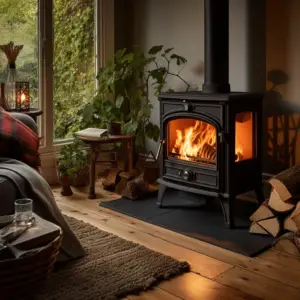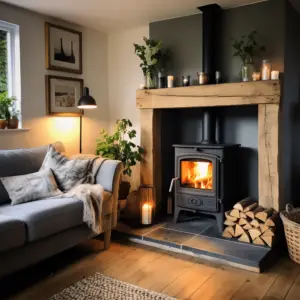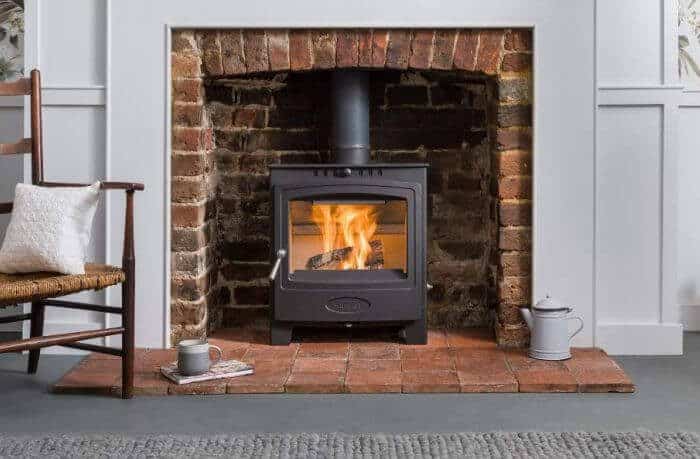Wood-Burning Stove Installation: If you have a fireplace in your home, you have probably stopped using it or find that using it can be cumbersome just to get some warmth into the home for a few hours.
The traditional fireplace, which is rather large and spacious is one of the least energy-efficient ways to create warmth for the room and the home in general.
Traditional fireplaces have the advantage of being aesthetically satisfying but are unfortunately energy wasters and tiresome to operate every now and then.
A better understanding of thermodynamics over the years has led to the invention of better appliances that burn fuel much more efficiently.
A wood-burning stove offers better thermal performance and it makes sense to install one in your fireplace. In most cases, it is an easy job to get this done but there are a few key factors you may need to consider in order to make this work as it should.
Table of Contents
Factors to Consider when Installing a Wood-burning Stove in a Fireplace

Consult a Professional
Installing the stove is a fairly straightforward process given that instructions come with the stove and that the stove is made precisely for installation in a pre-existing fireplace. The job however is not a DIY project and should not be attempted by anyone without construction knowledge.
The dangers you are likely to expose your home and family to far outweigh any cost benefit of installing the stove yourself so the first consideration is that you should hire a professional installer for this job.
Building regulations
Installing a wood-burning stove should not require any special permits but the finer details of any construction on your property should be cleared out with the authorities.
For instance, Wood-Burning Stove Installation intend to use fuels that emit smoke, you must ensure that the use of such fuels is not regulated or prohibited in your locality. If there are any modifications to be made to your chimney, you may be encroaching into regulated territory.
The Length and Diameter of your Flue
In many places traditionally, there was only a chimney but later, a flue which is a metal pipe that directs smoke and gases produced by fire out and into the atmosphere was introduced.
The chimney is the brick or stone housing that encases the flue. The chimney on its own is very wasteful and directs not only gases but also heat up and out of the room and into the atmosphere making the fire useless for providing heat. Wood-Burning Stove Installation allows cold air to into the house in huge amounts.
A flue, being narrower, creates a bottleneck effect which means anything dissipating out of the flue does so much slower so noxious gases are still released but significantly less warm air escapes the flue forcing it to lose its heat within the house first.
Less cold air can get sucked in through a flue since air movement through the narrower pipe is slowed down. The size of your flue must be an exact match with the one on the wood-burning stove and a difference will not only create disparity but could eventually cause fire accidents.
Size of your Hearth and Surround
Wood-Burning Stove Installation or hearth of the fireplace should be big enough to accommodate the new stove. In most instances, this is not an issue since traditional fireplaces were typically large in size but an ideal fit for the stove should allow enough room around the stove for maximum efficiency and safety.
Each wood-burning stove has specific regulations for its placement in regards to the hearth and surround of the fireplace so these should guide what kind of stove you need and the exact spot that it should be installed.
The size of the hearth and surround also informs the safety of anything and anyone around since wood-burning stoves can produce a lot of heat which could make it very uncomfortable to sit close to if the fireplace does not house it properly.
When fuelling the stove, insufficient distance from yourself could result in injury if embers break off and land on you or the floor in front of the fireplace.
Heat Output
This is the most crucial consideration when buying a wood-burning stove. Generally, a large room requires a larger stove with greater heat output while a smaller room should be fitted with a smaller stove. Regardless, only the exact measurements of the room will give you the best criteria for selecting a stove.
Other factors such as the type of stove and general climate of the region will also inform the kind of stove you require. If a stove produces a high heat output it will be uncomfortable and could create a shortage of air in a proportionally smaller room. Too little of the heat and it beats the purpose of acquiring a stove.
The Facade of your Fireplace

The facade or the front of your fireplace need not appear ugly just because the wood-burning stove is obviously not the original idea that was intended when the fireplace was constructed.
Part of the surround is the allowance at the foot of your fireplace and if space allows you can redo the entire facade to make it look better and more accommodating of the new stove. Most fireplaces sport imposing stone or brick walls and hearths which may look out of place with the small face and structure of the wood-burning stove.
Some well-applied plastering or covering up the stone with a non-combustible material that gels with the look of a wood-burning stove should make the place look much better. Additionally, you could fashion a beautiful and useful contraption on which to place chunks of wood or the increasingly popular smokeless briquettes as storage for your fuels.
Finally…
Installing a wood-burning stove in an existing fireplace is a great way to increase warmth in your home while cutting down significantly on the fuel output needed to achieve this.
While electrical heating systems may be the conventional route, one cannot argue the comfy rustic appeal that accrues from having a fire going as you warm up next to it on a cold evening.


